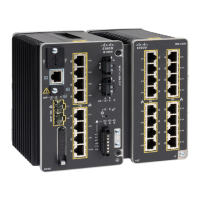1-3
Cisco IE 3000 Switch Software Configuration Guide
OL-13018-01
Chapter 1 Overview
Features
• Switch clustering technology for
–
Unified configuration, monitoring, authentication, and software upgrade of multiple,
cluster-capable switches, regardless of their geographic proximity and interconnection media,
including Ethernet, Fast Ethernet, Fast EtherChannel, small form-factor pluggable (SFP)
modules, Gigabit Ethernet, and Gigabit EtherChannel connections. For a list of cluster-capable
switches, see the release notes.
–
Automatic discovery of candidate switches and creation of clusters of up to 16 switches that can
be managed through a single IP address.
–
Extended discovery of cluster candidates that are not directly connected to the command switch.
Performance Features
The switch ships with these performance features:
• Autosensing of port speed and autonegotiation of duplex mode on all switch ports for optimizing
bandwidth
• Automatic-medium-dependent interface crossover (auto-MDIX) capability on 10/100 and
10/100/1000 Mb/s interfaces and on 10/100/1000 BASE-TX SFP module interfaces that enables the
interface to automatically detect the required cable connection type (straight-through or crossover)
and to configure the connection appropriately
• Support for up to 9000 bytes for frames that are bridged in hardware, and up to 2000 bytes for frames
that are bridged by software
• IEEE 802.3x flow control on all ports (the switch does not send pause frames)
• EtherChannel for enhanced fault tolerance and for providing up to 8 Gb/s (Gigabit EtherChannel)
or 800 Mb/s (Fast EtherChannel) full-duplex bandwidth among switches, routers, and servers
• Port Aggregation Protocol (PAgP) and Link Aggregation Control Protocol (LACP) for automatic
creation of EtherChannel links
• Forwarding of 2 packets at Gigabit line rate
• Per-port storm control for preventing broadcast, multicast, and unicast storms
• Port blocking on forwarding unknown 2 unknown unicast, multicast, and bridged broadcast traffic
• Internet Group Management Protocol (IGMP) snooping for IGMP Versions 1, 2, and 3 for
efficiently forwarding multimedia and multicast traffic
• IGMP report suppression for sending only one IGMP report per multicast router query to the
multicast devices (supported only for IGMPv1 or IGMPv2 queries)
• IGMP snooping querier support to configure switch to generate periodic IGMP general query
messages
• Multicast VLAN registration (MVR) to continuously send multicast streams in a multicast VLAN
while isolating the streams from subscriber VLANs for bandwidth and security reasons
• IGMP filtering for controlling the set of multicast groups to which hosts on a switch port can belong
• IGMP throttling for configuring the action when the maximum number of entries is in the IGMP
forwarding table
• IGMP leave timer for configuring the leave latency for the network
• Switch Database Management (SDM) templates for allocating system resources to maximize
support for user-selected features
